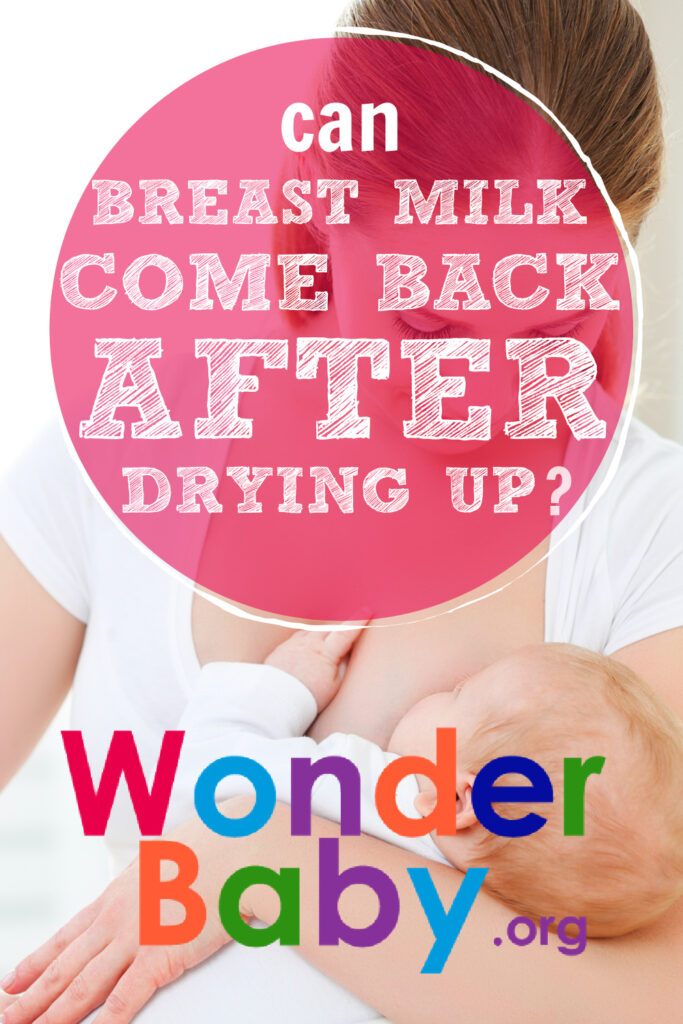Can Breast Milk Come Back After Drying Up?

- Breast milk can come back after drying up.
- Pumping or putting your baby to your breast frequently may lead to relactation.
- Mothers can still relactate for several weeks after their breast milk dries up.
- Maintaining a healthy diet and staying hydrated can help you increase your milk supply.
There are many reasons that a mother might stop breastfeeding her child. Some mothers may wean their babies and then realize they weren’t quite ready to stop breastfeeding after all. Others may be faced with a crisis and be forced to stop breastfeeding early. Some mothers may decide they want to start breastfeeding several days or weeks after delivering their baby.
Breastfeeding is already an emotional journey, but having breast milk dry up before you’re ready can be devastating for some moms.
If you’ve stopped breastfeeding but want to start back up again, you might be wondering if breast milk can come back after drying up. While it can be a long process, relactation is possible with some determination.
Relactation: What You Need to Know

Relactation is the process of helping the breasts begin milk production again after they have stopped. If you want to relactate, you will have to be prepared to spend a lot of time and energy working on your relactation journey.
Milk Supply Drying Up
Most mothers notice that their breasts completely stop milk production 2–3 weeks after they stop breastfeeding or pumping. Other reasons milk production may decrease include stress, dehydration, thyroid issues, or medications.
Can Breast Milk Come Back After Drying Up?
Breast milk can come back after drying up. The Cleveland Clinic11. Restarting breastfeeding: Relactation Tips. Cleveland Clinic. 2022. https://health.clevelandclinic.org/relactation states that mothers can relactate for up to four weeks after their original milk supply has dried up.
Milk production is caused by both hormones produced after delivery and stimulation of breast tissue. Since hormones do not immediately go away after you stop breastfeeding, some mothers are able to restore their milk supply after taking a break.
If you hope to stimulate milk production after you have stopped breastfeeding, you should speak with a lactation consultant. A lactation consultant can help you set realistic goals and expectations about re-establishing your milk supply.
How to Restore Breast Milk After Drying Up

The sooner you can return to breastfeeding, the easier inducing lactation will be. Following these relactation tips can increase your chances of restoring your full milk supply:
Breast Stimulation
The best way strategy to increase milk supply is to start breastfeeding. Put your baby to your breast when she cries or needs to be comforted. Your baby’s mouth will stimulate the breast tissue and tell your body to produce more milk.
Resuming breastfeeding after stopping requires a cooperative baby. Some previously breastfed babies who are returned to an empty breast may get frustrated if they are not getting any milk.
As you resume your breastfeeding relationship, make sure your baby’s latch is secure. Chances of relactation success are higher if both you and your child are comfortable during nursing sessions. Since you will have to spend lots of time nursing, a poor latch can cause pain for you and frustration for your baby.
Power Pumping
Many mothers use power pumping to increase milk production and build up a supply of pumped milk. Power pumping increases milk supply by telling your body that your baby needs more milk.
A lactation consultant can help you create a pumping schedule that works well for you and your baby. In general, the more you can use your breast pump, the more milk your breasts will produce.
Skin-to-Skin Time
Research shows22. Hurst, N. M., Valentine, C. J., Renfro, L., Burns, P., & Ferlic, L.. Skin-to-skin holding in the neonatal intensive care unit influences maternal milk volume. Journal of perinatology : official journal of the California Perinatal Association. 1997;17(3), 213–217. PMID: 9210077 that skin-to-skin time can affect how much milk a mother produces. A study of mothers with babies in the NICU showed that moms who had more time skin-to-skin with their babies had a better milk supply and more successful pumping sessions. Even though the NICU babies could not breastfeed in their early weeks of life, their mothers were able to produce enough milk for them by using a hospital-grade pump.
Spending time skin-to-skin has a positive effect on your baby’s health, whether or not they are breastfeeding.
Supplements
When you start to produce milk, you may need to eat more calories to support your breastfed baby. Experts at the Mayo Clinic33. Mayo Foundation for Medical Education and Research. Breastfeeding nutrition: Tips for moms. Mayo Clinic. 2022. https://www.mayoclinic.org/healthy-lifestyle/infant-and-toddler-health/in-depth/breastfeeding-nutrition/art-20046912 recommend choosing nutrient-dense and high-protein foods while breastfeeding.
Rather than focusing on a specific food group, it’s best to maintain a healthy and well-balanced diet while you work on increasing your breastmilk supply. It’s often recommended to include an iron supplement and take a prenatal vitamin to help you meet all of your nutritional needs while breastfeeding.
You may also want to try foods specially designed to increase breastmilk production like lactation cookies and teas.
Hydration
Not only do you need enough calories and protein to produce a full milk supply,but you also need to make sure you drink enough water. Staying well-hydrated is essential for all breastfeeding mothers.
Carry a water bottle with you and take sips of water all throughout the day. Breastfeeding mothers need about 128 oz of water each44. 2023. How Much Water Should I Drink While Breastfeeding?Milkology. 2023. https://milkology.org/content/how-much-water-should-i-drink-while-breastfeeding day to stay hydrated.
Check Your Medications
Some medications can make it more difficult to produce milk. Medicines like decongestants can actually dry up your milk supply.
If you take a prescription medication, talk to your healthcare provider about whether or not it might decrease your milk production.
Stay Calm
Remaining stress-free will help your body produce milk. Relactation can be a frustrating and time-consuming process, but try to stay relaxed as much as possible. Playing calming music while your baby nurses or asking your partner for help with other household duties can help you stay calm while you breastfeed.
How Long Does It Take for Breast Milk to Come Back After Drying Up?

Reestablishing a milk supply can be a long process. Lactation consultants at La Leche League54. Relactation and induced lactation. Breastfeeding nutrition: Tips for moms. La Leche League GB. 2021. https://www.laleche.org.uk/relactation-induced-lactation/#supplement state that it can take several weeks or even several months for breast milk to come back. You may not get a full supply of breastmilk or enough to exclusively breastfeed your baby, but every drop of breast milk is beneficial for your child’s health.
Mothers who use hormone therapy without being pregnant at all can expect to spend 2–4 months working on induced lactation before they will produce any milk at all.
How to Tell if Relactation Is Working
It might be hard to tell if your baby is getting more milk while they are at your breast. Watch for these signs that indicate that your milk supply is coming back:
- Hormonal changes. You may start feeling a little down just before your milk appears.
- Breasts feeling fuller or heavier, tingling, or getting hot.
- Feeling more thirsty throughout the day, especially while breastfeeding.
- Leaking milk and/or being able to hand express more milk.
- Your baby gains weight and produces yellow, mustard-colored poops.
- Your baby starts to refuse formula or other supplements.
The easiest and most obvious way to tell if relactation is working is to try hand expression or using a breast pump. At first, you may only get a drop or two of breastmilk. However, as you continue to stimulate the breasts, you will be able to express more milk.
Inducing Lactation
While rare, there have been some success stories of women who are able to produce human milk for their adopted babies. Women who have plenty of time to plan ahead may be able to start hormone therapy66. Kurke, M. A.. Induced lactation: Can I breastfeed my adopted baby?. Mayo Clinic. 2023. https://www.mayoclinic.org/healthy-lifestyle/infant-and-toddler-health/expert-answers/induced-lactation/faq-20058403 for inducing lactation.
Mothers who cannot or choose not to use hormone therapy may be able to induce lactation using only a breast pump. It might take several months of pumping with a hospital-grade pump before your body will start producing milk.
FAQs
Can I relactate just by pumping?
While it’s possible to relactate just by pumping, you are much more likely to produce breastmilk when you breastfeed your child. At the very least, you should include a lot of skin-to-skin contact with your baby.
Can I still get colostrum when relactating?
Colostrum is only produced right after giving birth. Your breasts will not produce colostrum when relactating.
Will relactation affect my period?
Relactation is unlikely to affect your period, unless you are using hormone replacement therapy. Many mothers have a normal menstrual cycle while they breastfeed their babies, and relactation does not usually produce enough hormones to affect your period.
When is it too late to relactate?
According to La Leche League, it is never too late to relactate. However, the longer you go without breastfeeding your baby, the more difficult it will be to re-establish a milk supply.
Is it worth it to relactate?
For mothers who feel strongly about wanting to breastfeed their babies, relactation is a worthwhile endeavor. Breastfeeding has many health benefits, and even just a little bit of breastmilk can be good for your baby.
However, relactation requires a lot of time and may be stressful for some mothers. Try to start your relactation journey with reasonable expectations about how much milk you will be able to produce. If relactation becomes too stressful or has a negative impact on your relationship with your baby, it’s okay to stop.
What are the risks of hormone therapy for lactation?
Hormone therapy for lactation often includes the supplementation of estrogen and progesterone. Side effects of this therapy are similar to side effects of different birth control medications and may include moodiness, bloating, weight changes, and hot flashes.
References
- Cleveland Clinic. (2022a, July 16). How To Reintroduce Lactation After Stopping Breastfeeding. Cleveland Clinic. https://health.clevelandclinic.org/relactation
- Hurst, N. M., Valentine, C. J., Renfro, L., Burns, P., & Ferlic, L. (1997). Skin-to-skin holding in the neonatal intensive care unit influences maternal milk volume. Journal of perinatology : official journal of the California Perinatal Association, 17(3), 213–217. PMID: 9210077
- Mayo Foundation for Medical Education and Research. (2022, April 27). Breastfeeding nutrition: Tips for moms. Mayo Clinic. https://www.mayoclinic.org/healthy-lifestyle/infant-and-toddler-health/in-depth/breastfeeding-nutrition/art-20046912
- Milkology. (2023, May 12). How Much Water Should I Drink While Breastfeeding? Milkology. https://milkology.org/content/how-much-water-should-i-drink-while-breastfeeding
- Relactation and induced lactation. La Leche League GB. (2021, June 27). https://www.laleche.org.uk/relactation-induced-lactation/#supplement
- Kurke, M. A. (2023, February 3). Induced lactation: Can I breastfeed my adopted baby? Mayo Clinic. https://www.mayoclinic.org/healthy-lifestyle/infant-and-toddler-health/expert-answers/induced-lactation/faq-20058403

The information WonderBaby provides is not intended to be, and does not constitute, medical or other health advice or diagnosis and should not be used as such. Always consult with a qualified medical professional about your specific circumstances.
Related Posts

Breastfeeding, Sleep
Sleep and Breastfeeding: A Comprehensive Guide for Nursing Moms
Many people assume breastfeeding and sleep training don’t go together, but it is possible to help your baby sleep better while continuing your breastfeeding journey.

Breastfeeding
Comfort Nursing: Pros, Cons, and How to Stop
Find out what comfort nursing is, when should you worry about it, and how to stop or limit your baby's comfort nursing (especially at night!).

Breastfeeding, Product Reviews
5 Best Breastfeeding Chairs for Nursing Moms of 2023
Whether you want a gentle rock, a smooth glide, or a cozy cuddle to soothe your baby to sleep, you’ll have your pick of the best breastfeeding chairs on the...